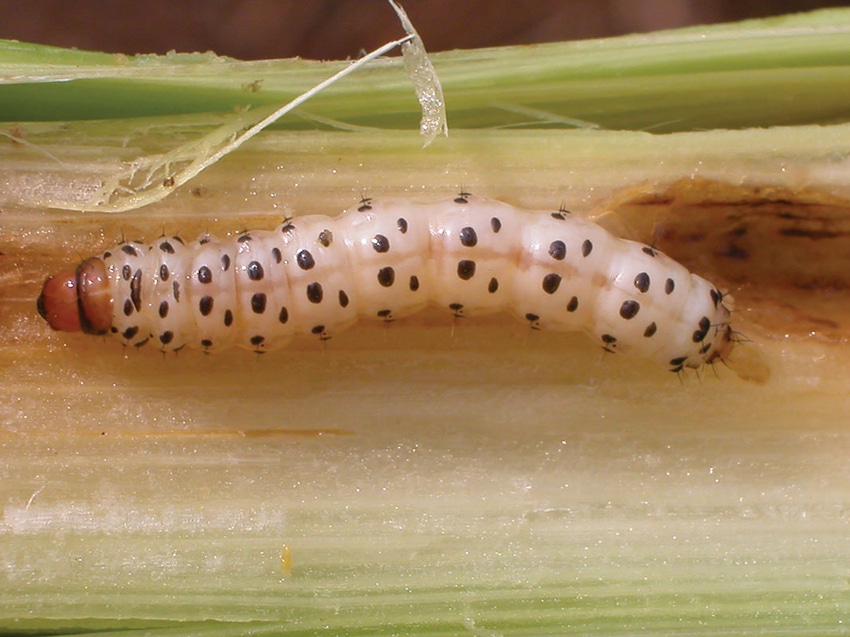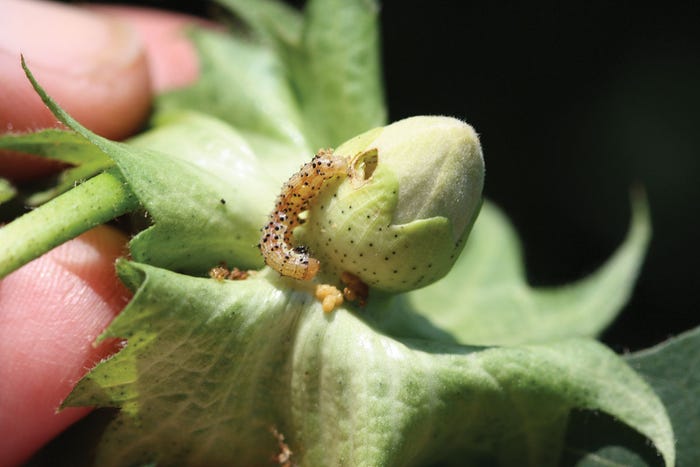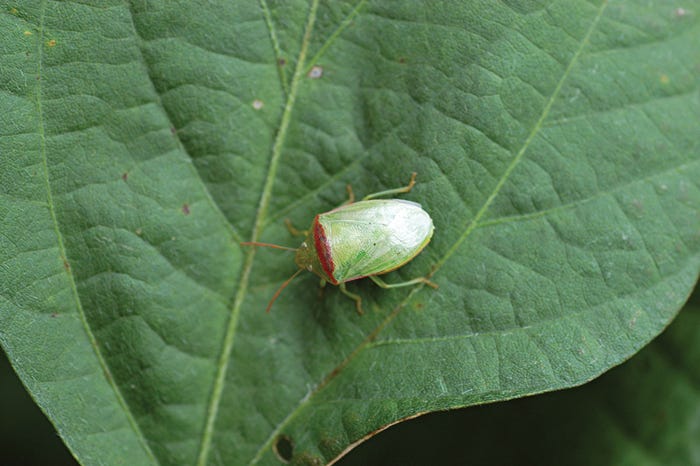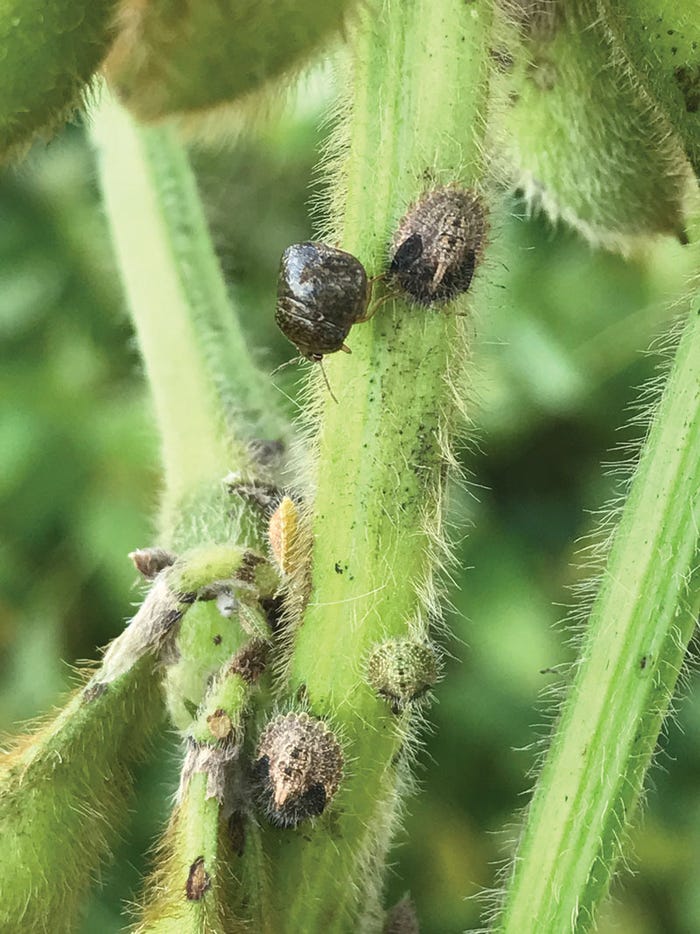
Mid-South cotton, soybean and corn growers benefit from an expansive portfolio of trait technology in varieties/hybrids, insecticides, biopesticides and cultural practices to manage insect pests.
These management products and practices are buttressed by extensive university research recommendations and scouting and from recommendations of the region’s professional independent crop consultants.
Here's the latest from regional university entomologists on major insect pests in Mid-South row crops — and what to do about them.
COTTON
University of Tennessee Extension entomologist Scott Stewart says thrips, plant bugs and bollworms are the “Big three” insect pests for cotton producers in his Mid-South state.

“For thrips we might need to lean more on chemistries such as Radiant or Intrepid Edge since our data indicate some issues with potential resistance in thrips to acephate,” says Stewart, who has been working with farmers and conducting research trials in west Tennessee for more than a decade.
“Additionally, AgLogic 15G (aldicarb) in-furrow granular is another option for thrips control in cotton. Cultural controls include cover crops or high residue production systems such as no-till that decreases issues with thrips. Manipulating planting dates can sometimes minimize thrips damage, but the optimum planting window in Tennessee is pretty narrow and it doesn’t give us too much flexibility; we plant when we can.”
Bayer Crop Science U.S. is developing cotton products that will include a trait that will help control lygus + thrips — which is on the horizon — according to Stewart, who is based at the West Tennessee Research and Education Center in Jackson.
Stewart does not expect any major changes in plant bug control next year. “We have good chemistries and good thresholds for managing plant bugs,” he says. “Mid-South growers had a relatively light plant bug year in 2019, but they still did a fair amount of spraying in some areas.”
His recommendations for plant bug control include Transform, which will have a full Section 3 EPA registration instead of a Section 18 emergency use exemption label for the first time in 2020; Orthene; Diamond; and Bidrin.
He recommends using Diamond at least once during the season, typically around bloom, plus or minus a week, because the insect growth regulator provides a different mode of action than everything else.
“Diamond does a good job of controlling immature plant bugs,” he says. “We often tank mix it with Orthene, Transform, or Bidrin since Diamond doesn’t control adult plant bugs. In the Mid-South, we have some concerns about development of resistance in tarnished plant bug populations to neonicotinoids like Centric and imidacloprid, which we’ve been relying on for early season control of adults. They still are being used during early squaring, but their days may be numbered.”
For bollworm management, Stewart notes the supply of Bollgard 3, TwinLink Plus and WideStrike 3 cotton varieties will be more plentiful in 2020, which will help control bollworms.
“This year we planted mostly Bollgard II varieties,” he adds. “Shifting more acreage to triple-gene varieties will be one big change for 2020 to battle bollworm resistance to older Bt cotton traits.”
University of Arkansas entomologist Dr. Gus Lorenz says the dominant insect pest for Arkansas row crops is the cotton bollworm or corn earworm, which infests cotton, corn, grain sorghum, soybeans and even tomatoes.
It is the No. 1 insect pest in soybeans, and No. 2 behind plant bugs in cotton in Arkansas, says Lorenz, a distinguished professor who works in cotton, soybeans, corn and rice with the University of Arkansas System Division of Agriculture.
“One control measure that more growers are adopting is a biological insecticide, Heligen, for the control of Helicoverpa spp. and Heliothis virescens larvae,” Lorenz says. “The virus is very specific for the bollworm/earworm species. It doesn’t have any off-target impact so it’s safe for bees, beneficials and birds.
“It’s mainly used in soybeans and is really effective in grain sorghum, but not as much in cotton because worms can hide in the fruit; this product must be ingested. It was used on about 250,000 acres last year, and close to 750,000 acres this year. The $5 per acre price tag is economical compared to some other control options. However, when we treat with a virus, we have to catch worms on the front end. It’s a living organism, not an insecticide.”
For plant bug control, Diamond insect growth regulator fits in well in cotton that has moderate to heavy plant bug pressure. “It’s very effective on nymphs and has become a standard for controlling plant bugs; it gets population spikes under control,” Lorenz says. “Use different chemistries and rotate them for plant bug control.”
Spider mites is another consistent insect problem in Arkansas cotton. Lorenz recommends using abamectin for the first application, and, if mites bounce back, he strongly encourages switching to Portal or Zeal.
Tarnished plant bugs are a major insect pest in Louisiana cotton. Louisiana State University entomologist Dr. Sebe Brown says, “We recommend prior to bloom that consultants sample with a sweep net, which is effective in catching migrating adults. When the crop transitions into bloom, we recommend switching to a drop cloth.”
Controlling another cotton insect pest, thrips, begins with an insecticide seed treatment. “Aeris is the best performing seed treatment in our trials,” Brown says. “We recommend an imidacloprid-based seed treatment with an acephate overtreatment, which results in a yield increase.
“Additionally, don’t hesitate on a foliar spray if needed,” says Brown, who is based at the LSU AgCenter’s Dean Lee Research Center in Alexandria, La. “When you see the first true leaf start to open up and the plant is working on the second one, apply a foliar application of Intrepid Edge, acephate or Bidrin.”
Bollworms are another major cotton insect pest. Brown says diamides control them well when an overspray is needed. “We encourage consultants to stay on top of egg lay,” he says. “On dual-gene cotton we’ve moved to a threshold of 20 percent eggs. On triple-gene cotton, we’re still on our damage threshold of six percent injury with the presence of live worms. We recommend Prevathon or Besiege when treatment is needed.
Thrips, plant bugs and bollworms are Mississippi’s big three insect pests in cotton, followed by spider mites. Thrips control starts with a seed treatment, according to Mississippi State University entomologist Dr. Angus Catchot.
“We recommend an imidacloprid-based seed treatment with the addition of acephate either applied in-furrow or as an overtreatment on the cottonseed,” he says. “Follow with foliar applications as needed. Additionally, AgLogic is gaining ground especially where nematodes are present. It provides excellent thrips control.”
Plant bugs are a habitual problem across the state, but particularly in the Delta. Catchot recommends an early Diamond shot around the third week of squaring when adults start migrating into the field.
“When we get into bloom, we can use materials such as acephate plus bifenthrin, Transform and Bidrin plus bifenthrin,” he adds.
Like the rest of the Mid-South, Mississippi mainly grows dual-gene cotton varieties that are yielding very well; growers mainly use diamides, Prevathon or Besiege, when an overspray is needed for bollworms.
“We can also get some help from high rates of pyrethroids plus acephate, particularly when approaching cutout, and it fits well if plant bugs need an application at that time,” Catchot says.
“I think we will see an increase in the VIP cottons such as Bollgard 3 XtendFlex, WideStrike 3, and TwinLink Plus in the near future. These three-gene cottons will reduce the number of sprays for bollworms but will still have to be scouted closely and managed for bollworms.”
Spider mites are a widespread problem and are intense in some locations. “I believe the problem is worsening because we’re not using as much glufosinate, which helped keep spider mites beat back, as we did earlier before we started moving into the dicamba (herbicide) system,” Catchot says.
“Early in the season, we want to avoid foliar applying disruptive insecticides, such as pyrethroids and acephate, which flare mites. For control we can use abamectin, Portal and Zeal. Abamectin is a cheap product that gets a lot of use, but resistance has been documented, and over the years we have had to increase rates to provide acceptable control. It will be important to rotate products with other modes of action in 2020 to provide consistent control.”
SOYBEANS
Another warm winter could increase the incidence of Redbanded stink bugs in 2020, says the University of Tennessee’s Stewart. Otherwise, West Tennessee will be focused on other stink bug species, the caterpillar complex and, to some extent, kudzu bugs.
“We’re consistently seeing more brown-marmorated-stink bugs,” Stewart says. “One good cultural approach is early planted soybeans, which consistently are the highest yielding beans and often outrun late season insect pests.

“I also strongly recommend using an insecticide seed treatment when planting into fields that had cover crops unless that cover crop is terminated well before planting. Additionally, we had to spray some for kudzu bugs in 2019. They’re not difficult to control with bifenthrin; one well-timed spray is sufficient.”
Redbanded stink bugs were bad in 2017, says the University of Arkansas’ Lorenz. “Then a hard winter knocked them out so they were not a problem in 2018, but they crept back into the state in 2019. They can be controlled with an acephate plus bifenthrin tankmix.”
The Redbanded stink bug issue in soybeans is exacerbated by mild winters, says the LSU AgCenter’s Brown. Early planting is the best way to manage red bands, which was not an option in 2019.
“We urge consultants and growers to check fields closely because redbands can flare from nothing to above threshold within three days,” Brown says. “Here in Louisiana, especially south of Alexandria, we recommend growers budget three to five insecticide applications for redbands. We can control them with acephate plus bifenthrin, which also catches other stink bug species and secondary pests.”
The stink bug complex, soybean loopers, and bollworms are the three biggest insect pests Mississippi farmers deal with annually in beans. “Depending on the year, we could have green stink bugs, southern green stink bugs, browns, and redbands,” Mississippi State’s Catchot says.
“They’re all primarily seed feeders and start coming into the fields at R5-R6 growth stages. What products or tankmixes of products we use depends on the species we’re going after. Greens and Southern Greens are easily controlled, browns are a little more difficult to control with pyrethroids alone — we often have to tankmix an organophosphate insecticide — and Redbanded stink bugs are controlled by tankmixes like acephate plus bifenthrin.
“Additionally, we can control bollworms in beans with Intrepid Edge, Besiege or Prevathon. In Mississippi, the number of bollworms we treat in soybeans is highly dependent on planting date. Typically, we tend to plant a lot of soybeans early, and they escape the bulk of the bollworm flight, but we deal with them on some acres every year. Catchot says soybean loopers tend to hit later in the season over a number of acres. “The diamides can knock populations down below threshold, but for the last couple of years we’ve been leaving more in the field, and residual is not quite as long as it used to be. The diamides typically will reduce populations of soybean loopers below threshold, but we’ve seen slippage over the last few years. Some of our main looper products are Intrepid Edge, Intrepid or Steward.”
CORN
Dual-trait corn hybrids give growers good control of the southwestern corn borer, and they are urged to use a diamide in conventional hybrids in refuge corn, says the University of Arkansas’ Lorenz.
Two preplant decisions are critical in managing insects in corn says LSU’s Brown. One is selecting a high yield potential hybrid with the trait technology needed to meet a field’s needs. The second decision is picking an insecticide seed treatment at the correct insecticide rate.

In Mississippi, the number one insect problem in corn is the soil insect complex, including wireworm, rootworm, white grubs, and sugarcane beetles. Decisions to control those insects must be made prior to planting by selecting the type of seed treatment to use. Whether to use low rates, mid rates or high rates depends on several factors, including field history, tillage practices and rotation.
“In non-Bt corn, we still watch for southwestern corn borer, and we conduct a state-wide trapping program to monitor for them,” Mississippi State’s Catchot says. “Methoxyfenozide products and diamides work well controlling southwestern corn borer.
“Additionally, we’ve been dealing more with brown stink bug in seedling corn in some parts of the state. They’re difficult to scout for, and we use pyrethroids, particularly bifenthrin, for control.
“To best manage insects in all crops, it’s critical to know what and how many insect pests are in the field. This is why it’s so important to have an independent crop consultant putting footprints in the field on a weekly or bi-weekly basis to identify what’s out there so growers can choose the right product against the right pest.”
For the last couple years, West Tennessee corn has seen substantial damage from wireworms in some fields, particularly when the 250 insecticide seed treatment rates were used.
“We will recommend bumping up the insecticide seed treatment to the 500 or higher rates in 2020,” the University of Tennessee’s Stewart says, “or applying an insecticide like a pyrethroid in-furrow.
“Other than that, we’ll have hot spots of southwestern corn borer in non-Bt corn. They were a substantial problem in a limited number of fields in West Tennessee this year. We have some excellent insecticides to control them in our refuge corn, but it does require scouting and running moth traps. Growers can use materials such as Prevathon, Besiege, Intrepid, Blackhawk and pyrethroids.”
About the Author(s)
You May Also Like




